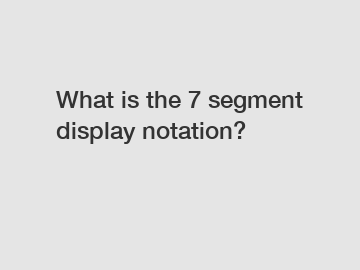What is the 7 segment display notation?
Have you ever wondered about the history and significance of the 7 segment display notation? If so, you're not alone. This simple yet versatile display technology has been a staple in electronics for decades, but many people may not fully understand how it works or why it's so popular. In this blog post, we'll delve into the world of 7 segment displays, exploring their origins, their applications, and their enduring appeal.
To begin with, let's take a closer look at what exactly a 7 segment display is. Essentially, a 7 segment display is a type of electronic display device that consists of seven basic segments arranged in the shape of the number "8". Each segment can be individually turned on or off, allowing for the display of numerical digits as well as some letters and symbols. The simplicity and versatility of the 7 segment display make it ideal for a wide range of applications, from digital clocks and calculators to scoreboards and traffic lights.
The origins of the 7 segment display can be traced back to the early days of electrical engineering, when researchers were exploring new ways to visualize numerical data. In the 1950s and 1960s, engineers began experimenting with various types of display technologies, including the vacuum fluorescent display and the nixie tube. However, it wasn't until the development of the light-emitting diode (LED) in the 1970s that the modern 7 segment display as we know it today truly began to take shape.

One of the key advantages of the 7 segment display is its simplicity and ease of use. Unlike more complex display technologies, such as liquid crystal displays (LCDs) or organic light-emitting diodes (OLEDs), the 7 segment display requires only a minimal amount of control circuitry to operate. This makes it an attractive option for designers looking to add a digital readout to their products without the need for complicated programming or specialized components.
In terms of notation, the 7 segment display uses a simple and intuitive system to represent numbers. Each of the seven segments is assigned a specific position and label, ranging from "a" to "g". By selectively activating and deactivating these segments, it's possible to create any numerical digit from 0 to 9. For example, to display the number "2", you would activate segments "a", "b", "g", "e", and "d", while leaving segments "c" and "f" off.
Of course, the 7 segment display isn't limited to just numbers. With a bit of creativity, it's also possible to use the display to show some letters and symbols. For instance, by combining various segments in different patterns, you can create letters of the alphabet, punctuation marks, and even simple icons. This flexibility and versatility make the 7 segment display a popular choice for a wide range of applications, from digital signage and consumer electronics to industrial automation and beyond.
In conclusion, the 7 segment display notation is a timeless and versatile technology that continues to play a key role in modern electronics. Its simplicity, ease of use, and flexibility make it an ideal choice for a wide range of applications, from everyday consumer products to complex industrial systems. Whether you're a seasoned engineer or just curious about how digital displays work, the 7 segment display is sure to capture your imagination and spark your creativity. So next time you see a digital clock or calculator, take a moment to appreciate the ingenuity and elegance of the humble 7 segment display.
If you are looking for more details, kindly visit Fuel Dispenser Liquid Crystal Module Manufacturer, Wide Temperature Electricity Meter Panel, HTN Flow Meter LCD Supplier from China.
182
0
0

Comments
All Comments (0)